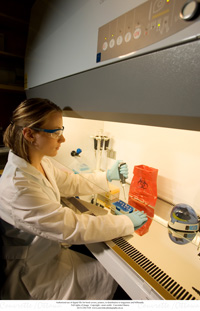Laboratories and research support: soil biotechnology laboratory
| Article Title |
|---|
Soil Biotechnology Laboratory |
The Soil Biotechnology Laboratory within the Biological Assessment and Standardization Section is responsible for biological test method development in soil microbial research.

Located in the S&T Laboratories in Ottawa, Ontario, research and findings from the laboratory are used to make decisions regarding the best approach to protect Canadians and their environment from risks some substances, and combinations of substances, may pose.
The laboratory is a Containment Level 2 facility for research involving risk group 2 pathogens.
Current research and methodology
- Development of measurement endpoints for soil microbial toxicity
- Optimization and validation of test methodologies for the characterization of microbial products containing microbial consortia or blends
- Development of DNA microarrays for the detection of terrestrial soil pathogens using genetic fingerprints unique to the microbial species
- Assessment of genomic techniques including DNA microarrays and multiplex polymerase chain reaction to detect microbial species of concern to Environment Canada
- Assessing new technologies to enhance DNA extraction efficiency from soils
A recent project involved amplified fragment length polymorphism (AFLP)-derived, strain-specific genetic fingerprints to assess the persistence of high priority Domestic Substance List microbial strains in soil microcosms. This data can be used to inform the regulatory process managing the New Substance Notification Regulations, and further protect Canadians against harmful microbial substances that have the potential for ending up in the environment. These methods are being developed into a guidance document for use in other government and commercial laboratories.
Some methods used include:
- polymerase chain reaction (PCR)
- quantitative PCR (qPCR)
- gel electrophoresis
- denaturant gradient gel electrophoresis (DGGE)
- microfluidic gel electrophoresis
- single and multi-well spectrophotometry
- multi-well fluorescence spectrophotometry
- phase contrast, differential interference contrast (DIC), epifluoresence and bright field microscopy
- segmented flow analyzer
Collaboration

Collaborative research includes:
- Assessment of the effects of Domestic Substance List microbial species to single species tests
- Development and standardization of new toxicity test methodologies and guidance for assessment and remediation of impacts from hydrocarbon and brine contamination on boreal forest, taiga and northern soils using ecologically-relevant organisms
Current laboratory research funding comes from government programs including the Strategic Technology Applications of Genomics for the Environment (STAGE), Canadian Regulatory Systems for Biotechnology (CRSB), and the Program for Energy Research and Development (PERD).
Experts in laboratory
Further reading
- Biological Test Method publication series, Environment Canada
- Xiang, S.-R., M. Cook, S. Saucier, P. Gillespie, R. Socha, R. Scroggins and L.A. Beaudette. 2010. Development of AFLP-derived functional strain-specific markers to assess the persistence of 10 bacterial strains in soil microcosms. Applied and Environmental Microbiology (Submitted)
- Providenti, M.A., M. Begin, S. Hynes, C. Hause, D. Chitty, J. Rahn, L.A. Beaudette, R. Scroggins and M.L. Smith. 2009. Towards the development of a generalized approach for identifying and applying strain-specific genetic markers for quantitative PCR-based tracking of microorganisms in the environment: results with Bacillus and Paenibacillus sp. released in soil. Canadian Journal of Microbiology 55:1166-1175.
- Environment Canada’s S&T Into Action: Protecting Canada’s boreal forest and northern ecosystems: developing biological methods to assess soil environments of the north.
- New Substances Program, Environment Canada
- Canada’s Biotechnology Strategy, Health Canada
- Canada’s Chemical Substances, Government of Canada
- Chemicals Management Plan, Government of Canada